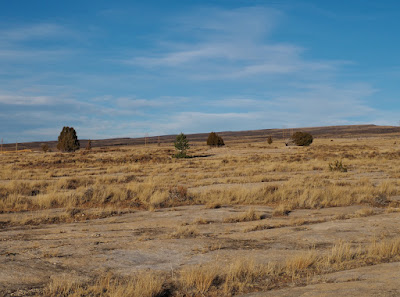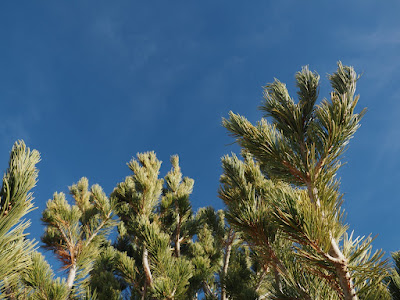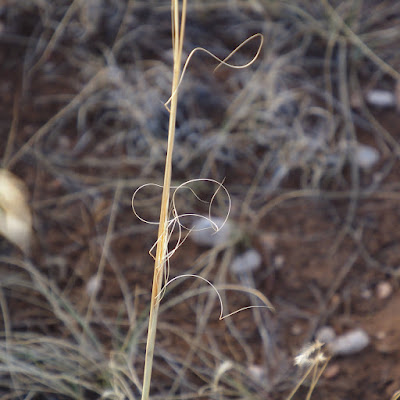When friends asked where I was going on my trip last September, I learned to say "Mono Lake". It was the only place in central eastern California they knew. I actually intended to visit volcanos, but "Mono Lake" turned out to be an acceptable answer. I stopped there most days to enjoy its peacefulness, strange rock sculptures, and oddly simple ecosystem.
Judging by the responses I got—usually something like "Isn't that where LA gets its water?"—Mono Lake is best known for the destruction wrought by the City of Los Angeles. After 1941, when the northern extension of the Los Angeles Aqueduct was completed, the lake dropped 45 feet, losing half its volume. Thanks to strong advocacy it has risen since 1994, but is still below the management level set by the California State Water Resources Control Board (more here).
To be clear, Los Angeles takes water not from Mono Lake but from the creeks flowing into it. The lake itself is much too salty, as Mark Twain noted in 1872:
"its sluggish waters are so strong with alkali that if you only dip the most hopelessly soiled garment into them once or twice, and wring it out, it will be found as clean as if it had been through the ablest of washerwomen's hands. ... If we threw the water on our heads and gave them a rub or so, the white lather would pile up three inches high."
 |
| Rather Soapy (from Roughing It) |
Twain and his companions had come to Mono Lake by way of the Great Basin in Utah, Nevada and eastern California—a land of internal drainage:
"Water is always flowing into [the lakes]; none is ever seen to flow out of them, and yet they remain always level full, neither receding nor overflowing. What they do with their surplus is only known to the Creator."
I think Twain knew more than he let on. Evaporation could keep lake level constant in spite of water flowing in. And evaporation would make it "alkali". Maybe he just wanted to add another flourish to his story.
The party camped along one of the creeks flowing into Mono Lake. They rented a boat from a local rancher, and "soon got thoroughly acquainted with the Lake and all its peculiarities." Twain was not impressed. He considered it "one of the strangest freaks of Nature ... a solemn, silent, sailless sea". It was aptly called The Dead Sea of California:
"There are no fish in Mono Lake—no frogs, no snakes, no polliwigs—nothing, in fact, that goes to make life desirable. Millions of wild ducks and sea-gulls swim about the surface, but no living thing exists under the surface, except a white feathery sort of worm, one half an inch long, which looks like a bit of white thread frayed out at the sides. ... Then there is a fly ... you can see there a belt of flies an inch deep and six feet wide, and this belt extends clear around the lake."
 |
| Mono Lake's flies still "swarm up so thick that they look dense, like a cloud." (House Photography) |
Today Twain is criticized for equating Mono Lake with the Dead Sea. But in spite of his disparaging remarks, he often was correct in his descriptions. Indeed there are just a few kinds of critters in the water, and they occur in abundance. In fact, they occur
by the trillions! I found this fascinating—a hostile environment, a simple ecosystem, and yet so productive.
 |
| To everything there is a season—Mono Lake in May. |
When I was in the area last May, Mono Lake fooled me. From atop
Panum Volcano I saw a lush green field east of the lake—alfalfa?? I drove to
South Tufa, where the field revealed itself to be vividly green water. I immediately thought "nitrates" ... or even worse, "sewage".
But Google assured me I needn't worry. In May, Mono Lake typically is thick with green algae madly photosynthesizing. This is truly their moment in the sun. They can flourish because the grazers are still asleep.
These algae are minute. For example Dunaliella is just 0.025 mm long. But it occurs in such abundance that it colors the water green ... until it gets eaten.
 |
| The color was unreal, even up close. |
 |
| Mono Lake in September. |
When I returned in September, the water was clear and flies were abundant along the lake shore—just as Twain had described. At the
Mono Basin Scenic Area Visitor Center, a worthwhile exhibit explained what had happened while I was away.
As Mono Lake warmed in spring, trillions of dormant life forms on the bottom awoke. From miniscule brown cysts emerged tiny larvae, the first stage leading to adult
Mono Lake brine shrimp (
Artemia monica, found nowhere else in the world). The shrimps feasted on algae and reproduced at an impressive rate, reaching astronomical numbers.
 |
| Mono Lake brine shrimp, about 1 cm long. This is Twain's "feathery sort of worm" (djpmapleferryman). |
At the same time, tiny eggs hatched to release larvae of
alkali flies (
Ephydra hians). After several stages underwater, adults emerged at the surface. They too fed on algae, reproduced, and soon achieved numbers in the trillions. No wonder the water was clear in September!
 |
| Alkali flies are fine to hang out with. They don't bite, sting, or otherwise bother humans (photo source). |
 |
| Like other Mono Lake aquatic life, alkali flies are small (4–7 mm) and super abundant. |
At first glance, it seems life is not so easy for alkali flies. Unlike their fully aquatic larvae, and unlike brine shrimp, adult alkali flies breath air. Therefore when they crawl down to the bottom of the lake to feed and lay eggs, they have to bring along their own oxygen! But this isn't a problem. Their dense covering of wax-coated hairs causes a bubble to form when the fly enters the water (its eyes remain exposed) (Young 2017).
Here Mark Twain again demonstrated his perspicacity:
"You can hold [the flies] under water as long as you please—they do not mind it—they are only proud of it. When you let them go, they pop up to the surface as dry as a patent office report, and walk off as unconcernedly as if they had been educated especially with a view to affording instructive entertainment to man in that particular way."
 |
| Alkali fly in its bubble (van Bruegel & Dickinson 2017). |
Of course to be complete, we must acknowledge the decomposers. Without them the ecosystem would be overwhelmed and cease to function. Throughout the warmer months bacteria on the lake bottom break down and consume the dead ... algae, shrimp, and flies.
Now with bacteria added, we have a completes list of aquatic inhabitants of Mono Lake—a very short list. Being human, of course we wonder "why?" Mono Lake's inhospitable waters probably drive ecosystem simplicity. Only a few species are adapted to survive. However not only do they survive, they thrive! A single cubic foot of near-shore water in summer contains 50–400 brine shrimp, 5,000–10,000 alkali flies and their larvae, and single-celled algae beyond counting. Is this great abundance due to lack of competition and predation? Sounds like a reasonable hypothesis to me.
After my final stop at Mono Lake I left feeling lucky, as I often do on these trips—lucky to have such wonderful public lands to enjoy, and lucky to be human and able to ponder nature's mysteries.
Sources
Unless otherwise cited, information is from the Mono Lake Committee website and exhibits at the Mono Basin Scenic Area Visitor Center.
Twain, Mark (Clemens, Samuel). 1872. Roughing It. Courtesy University of Virginia English Department.
van Bruegel, F, and Dickinson, MH. 2017. Superhydrophobic diving flies (Ephydra hians) and the hypersaline waters of Mono Lake. PNAS
Young, Emma. 2017. How alkali flies stay dry. Nature, NEWS, 20 November























































